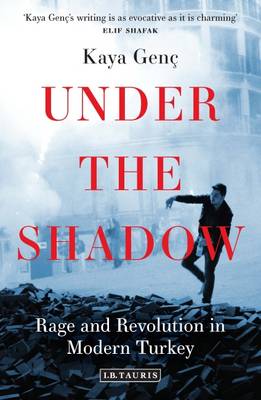INDEX ON CENSORSHIP
 Kaya Genç will be speaking at upcoming events in London on 12 and 15 September
Kaya Genç will be speaking at upcoming events in London on 12 and 15 September
In his new book, Under the Shadow: Rage and Revolution in Modern Turkey, Index on Censorship magazine contributing editor Kaya Genç explores the country’s struggles through the eyes of Gezi Park protesters, pro-government conservatives, artists, censored journalists and more.
“This is your future … if your generation does not fight for it, it will be a disastrous one.”
Recently I took a walk down Istanbul’s central Istiklal Street. Every day here crowds of pedestrians float around in small groups, surrounded by the cries of street vendors and the ding-dongs of tramvay, Istiklal’s beloved old wooden streetcar that travels up and down this populous shopping quarter from seven in the morning to ten thirty at night. When I feel overwhelmed by this crowded city I wander by the Bosphorus Strait and watch the reflections of the sun on the slow waves of the Marmara Sea. But on lonelier days I prefer to mix with the crowds of Istiklal and come across new fashions, new people, new ideas. On that Friday I came all the way to the middle of Istiklal, to a square called Galatasaray, to sit down and enjoy a cup of strong black Turkish coffee. A little bell rang as I opened the door to a small and serene coffee shop. Taking a seat, I began listening to a song by the Kurdish singer Aynur on my headphones, and typed up the opening paragraph of a new chapter in my novel. I felt lucky to be living in such a beautiful and vibrant and history-filled city. As I wrote, I entered my fictional world and felt at peace.
At some point I looked up as the hand of a young man appeared silently against the thick glass of the coffee shop window. The hand banged the glass loudly, passionately, one, two, three times and I saw that he had company: a darkhaired youth carrying a bright flag that bore the colours red, yellow and green, which signalled Turkey’s Kurdish political movement. Seconds later, a group of high school students followed behind them and the crowd began to force its way into the shop, signs of panic discernible on their faces. A cup fell and broke. Almost immediately a cloud of smoke enveloped the first activist as the street leading to the square filled grimly with the outlines of heavily armed riot cops marching towards us in single file, chasing this small group of rebels. The barista instantly rushed to the doorway; in an attempt to save her customers from the swiftly approaching cloud of smoke and tear gas, she let the protestors inside, closed and locked the door, and took down the shutters. For a few moments, in the darkness, it seemed as if we were safe from harm – but that was before we realized the air conditioning was still working. It took 15 seconds for the interior of the five-square-metre room to fill with tear gas. If you have ever come into contact with tear gas you will know how every breath you take burns your insides, how your eyes sting – and my mind, filled with joy, ecstasy and serenity only three minutes ago, was now occupied by the question of whether I would survive this experience alive. Apparently, while I was travelling through my fictional world, a protest had kicked off in the adjacent square, which the police had forcefully suppressed.
Index on Censorship for more
